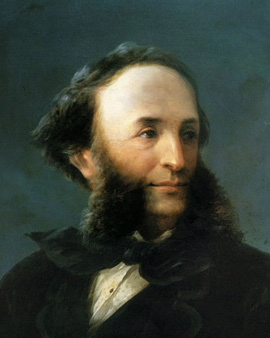Ivan Konstantinovich Aivazovsky was one of the most prominent Russian artists of the 19th century. As an official painter of the Russian Navy, he maintained close relations with the highest military ranks of the Russian Tsarist Empire. Aivazovsky took part in numerous maneuvers of the Russian Navy and artistically documented Russia's naval power. Naval painting enjoyed great popularity in the 19th century, as the navy played a central role in the imperial aspirations of the colonial powers as a national prestige project. Aivazovsky received correspondingly high recognition in other European countries. Aivazovsky underwent classical training at the St. Petersburg Academy of Art, where he specialized in landscape painting and battle scenes. As an outstanding graduate of the academy, he became popular with commissioned works for the Russian admiralty.
Throughout his life, the genre of marine painting determined the entire oeuvre of Aivazovsky, who was born in the Crimea and left behind an extensive oeuvre of over 6000 paintings. A deep impression on the artist was left by two historical events which directly affected him through his home country and his ancestry. The Crimean War intensified his nationalist perspective, which still makes him one of the most famous visual artists in Russia today. The genocide of the Armenians in the 1890s found its way into the late work of the Armenian-born painter.
Aivazovsky began his career under the strong influence of romantic landscape painting. Accordingly, his early seascapes focused on the power of the elements and man's struggle against the superiority of the natural forces of the sea. A four-year trip to Europe, during which he discovered Italian Renaissance art in particular, and an encounter with the British painter William Turner had a lasting influence on his artistic development. However, while Turner, who was deeply impressed by Aivazovsky's works, moved towards a dematerialization of the representational, Aivazovsky increasingly resorted to realistic modes of representation in his seascapes.
×





.jpg)
.jpg)
.jpg)
.jpg)
.jpg)
.jpg)
.jpg)
.jpg)
.jpg)
.jpg)
.jpg)
.jpg)
.jpg)
.jpg)
.jpg)
.jpg)
.jpg)
.jpg)
.jpg)
.jpg)
.jpg)
.jpg)
.jpg)
.jpg)
_1886_Brest_Museum_of_Fine_Arts_-_(MeisterDrucke-951408).jpg)
_1886_Brest_Museum_of_Fine_Arts_-_(MeisterDrucke-951408).jpg)
.jpg)
.jpg)
.jpg)
.jpg)
.jpg)
.jpg)
.jpg)
.jpg)
.jpg)
.jpg)
_-_(MeisterDrucke-1317832).jpg)
_-_(MeisterDrucke-1317832).jpg)
 1841 - (MeisterDrucke-65929).jpg)
 1841 - (MeisterDrucke-65929).jpg)
_Painting_by_Ivan_Consta_-_(MeisterDrucke-951700).jpg)
_Painting_by_Ivan_Consta_-_(MeisterDrucke-951700).jpg)
.jpg)
.jpg)
.jpg)
.jpg)
.jpg)
.jpg)
.jpg)
.jpg)
.jpg)
.jpg)
.jpg)
.jpg)
.jpg)
.jpg)
.jpg)
.jpg)
.jpg)
.jpg)
.jpg)
.jpg)
.jpg)
.jpg)
.jpg)
.jpg)
.jpg)
.jpg)
.jpg)
.jpg)
.jpg)
.jpg)
.jpg)
.jpg)
.jpg)
.jpg)
.jpg)
.jpg)
_e_-_(MeisterDrucke-1320753).jpg)
_e_-_(MeisterDrucke-1320753).jpg)
.jpg)
.jpg)
.jpg)
.jpg)
.jpg)
.jpg)
_Peinture_de_Ivan_Konstantinov_-_(MeisterDrucke-1320641).jpg)
_Peinture_de_Ivan_Konstantinov_-_(MeisterDrucke-1320641).jpg)
.jpg)
.jpg)
.jpg)
.jpg)
.jpg)
.jpg)
.jpg)
.jpg)
.jpg)
.jpg)
.jpg)
.jpg)
.jpg)
.jpg)
_Peinture_de_Ivan_Konstantin_-_(MeisterDrucke-1323578).jpg)
_Peinture_de_Ivan_Konstantin_-_(MeisterDrucke-1323578).jpg)
.jpg)
.jpg)
_Peinture_de_Ivan_Konstantinovich_Aivazosky_(I_-_(MeisterDrucke-1313770).jpg)
_Peinture_de_Ivan_Konstantinovich_Aivazosky_(I_-_(MeisterDrucke-1313770).jpg)
.jpg)
.jpg)
.jpg)
.jpg)
.jpg)
.jpg)
.jpg)
.jpg)
.jpg)
.jpg)
_-_(MeisterDrucke-1317776).jpg)
_-_(MeisterDrucke-1317776).jpg)
 - (MeisterDrucke-653090).jpg)
 - (MeisterDrucke-653090).jpg)
.jpg)
.jpg)
.jpg)
.jpg)
.jpg)
.jpg)
.jpg)
.jpg)
.jpg)
.jpg)
.jpg)
.jpg)
.jpg)
.jpg)
.jpg)
.jpg)
.jpg)
.jpg)
.jpg)
.jpg)
.jpg)
.jpg)
.jpg)
.jpg)
.jpg)
.jpg)
.jpg)
.jpg)
.jpg)
.jpg)
.jpg)
.jpg)
.jpg)
.jpg)
.jpg)
.jpg)
.jpg)
.jpg)
_Peinture_d_Ivan_Aivazovski_(Aiv_-_(MeisterDrucke-1028763).jpg)
_Peinture_d_Ivan_Aivazovski_(Aiv_-_(MeisterDrucke-1028763).jpg)
.jpg)
.jpg)
_Peinture_de_Ivan_Konstantinovich_Aiva_-_(MeisterDrucke-1321088).jpg)
_Peinture_de_Ivan_Konstantinovich_Aiva_-_(MeisterDrucke-1321088).jpg)
.jpg)
.jpg)
.jpg)
.jpg)
.jpg)
.jpg)
_-_(MeisterDrucke-1319815).jpg)
_-_(MeisterDrucke-1319815).jpg)
.jpg)
.jpg)
.jpg)
.jpg)
.jpg)
.jpg)
.jpg)
.jpg)
.jpg)
.jpg)
.jpg)
.jpg)
.jpg)
.jpg)
.jpg)
.jpg)
.jpg)
.jpg)
_Peinture_dIvan_Constan_-_(MeisterDrucke-1014495).jpg)
_Peinture_dIvan_Constan_-_(MeisterDrucke-1014495).jpg)
.jpg)
.jpg)
.jpg)
.jpg)
.jpg)
.jpg)






